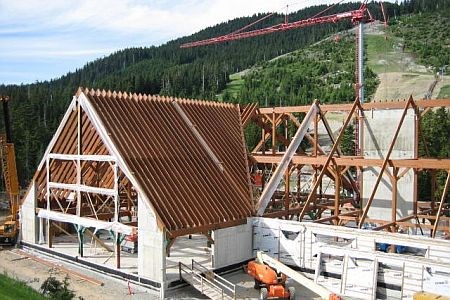Mark Angelini returned this winter from international wood product shows with a bushelful of business ideas for Ontario wood producers and he’s anxious to share them with the industry.
Mark Angelini returned this winter from international wood product shows with a bushelful of business ideas for Ontario wood producers and he’s anxious to share them with the industry.
The president and CEO of
Ontario Wood spent February and March attending the Korean Housing Brand Fair in Seoul and took in the annual Ecobuild show in London, among the dozen exhibitions he attends in Canada and around the world.
Next was the Interzum show in Guangzhou, China in late March, an interiors and furniture show where distributors and suppliers were looking for Canadian hardwood.
When companies enter tough times, those that serve foreign markets, reap the benefits, “although they don’t enjoy the same level of margins (domestically) as when times are hot.” However, a little advance reconnaissance by Ontario wood product companies on the international front now, meaning overseas, can be a great buffer against the regular cyclical downturns in the North American housing market, said Angelini.
Compared to the home foreclosures in the U.S., Europe’s economy is not suffering as badly and they say the pent-up consumer demand will lead to new construction. Based on his travels, Angelini said Germany and Latvia are always willing business partners since wood construction is second nature. In Italy and Spain, it’s a harder sell because of their traditional reliance on concrete home construction.
“Worldwide, everything is still slower than usual, but markets other than the U.S. seem to be showing signs of picking up.”
Angelini, a trained chemist, who started with Domtar’s chemical groups in 1973 before shifting into wood preserving and later engineering and management positions across Canada, has been encouraging companies to look abroad for years. The association started out in 2006 as the Ontario Wood Product Exports Association. They’ve since shortened the name to Ontario Wood.
Unless it's a market access issue, the group refrains from government lobbying seeking instead to drum up trade opportunities for its membership. They also lead and host outbound and incoming trade missions.
A big priority with the 24-member association is to attract more Northern Ontario companies. Eleven Northern companies have already signed on, but Angelini is looking for more. It’s a big reason why Ontario Wood has set up a presence in Sault Ste. Marie.
“There are a number of shows I go to where there is a demand for hardwood flooring and we don’t have any members that are strong in that category.”
The member companies range from primary producers of dimensional lumber and timber, to makers of complete manufactured home packages, everything that overseas customers are looking for.
Other associated members include FP Innovations which offers technical market research.
Angelini said a number of Ontario log home manufacturers have returned from overseas exhibitions with business deals.
Although Angelini is based in Markham, which helps with international air travel connections, the association’s office is headquartered in the Sault at the Great Lakes Forestry Centre, a federal government forestry lab. He acknowledges that with many forest product companies being in “survival mode”, spending a $500 annual membership fee is onerous to some.
But members can recoup that money by participating in one international trade show. Ontario Wood provides the booth space (which can range between $1,500 to $10,000 depending on the international show) plus newsletters and studies filled with business leads.
Convincing more Ontario companies, traditionally reliant on the U.S. market, to take the long-view and make the leap off-shore has always been a tough sell. There is always the “fear of the unknown” when it comes to logistics, customs access and cultural business practices.”
“There’s a reluctance to change,” said Angelini.
However, many members have vast international experience and are willing to share what they’ve learned. Plus, the association has numerous government contacts including trade commissioners.
“We can lead companies to the right areas.”
In the past, some Asian overseas distributors were angry with Canadian producers for abandoning them when U.S. markets improved. But Angelini didn’t sense that animosity existing anymore after attending a show in Japan in November.
“It’s very short-term thinking to develop a customer overseas and then drop them as soon as they see something better.”
